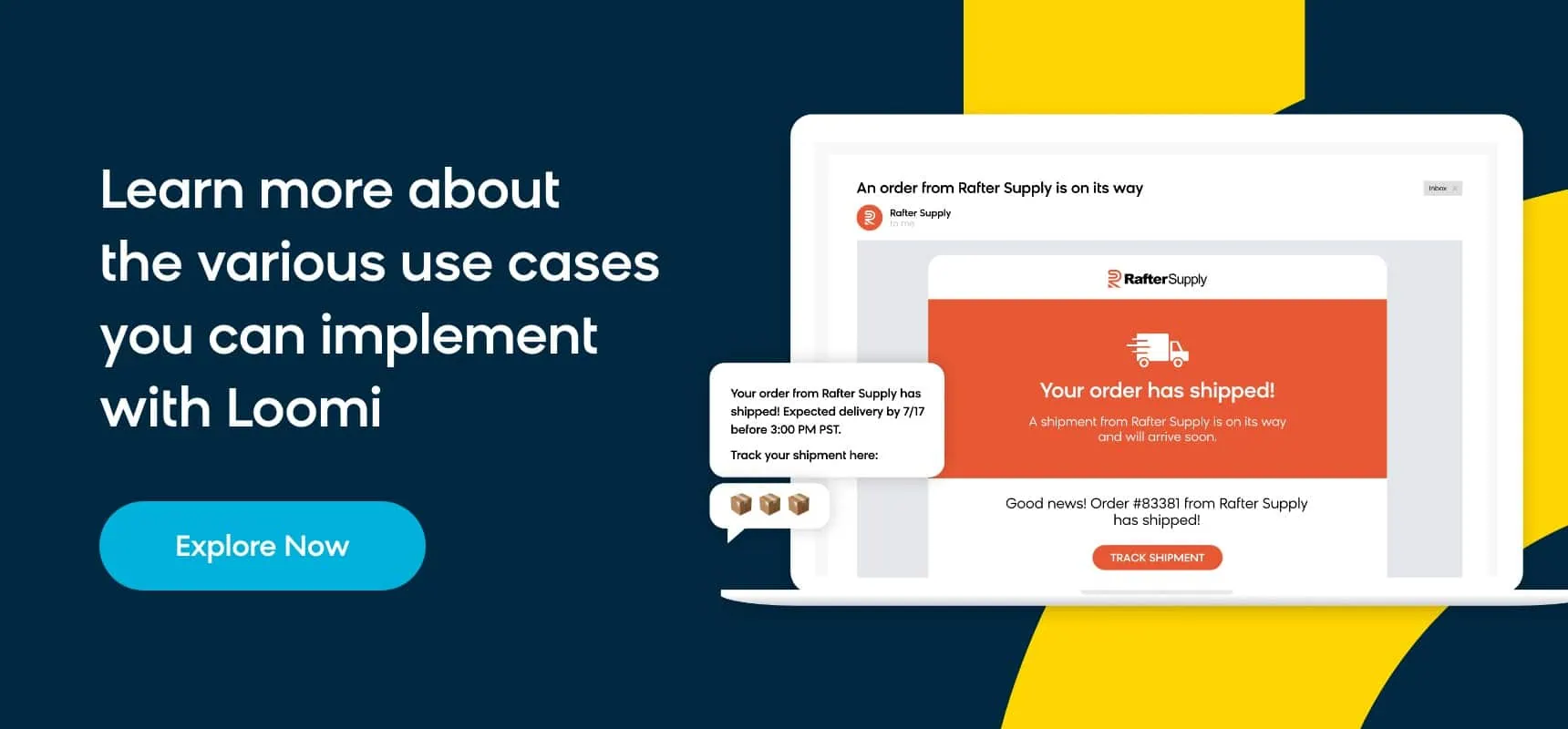The COVID-19 pandemic caused a 55% surge in online spending as high-street shops were shut down. It sparked a transformation in the way consumers shop, with retail ecommerce anticipated to grow 56% by 2026.
To keep pace with change, 84% of ecommerce retailers are turning to advanced technologies like artificial intelligence (AI) and machine learning. With the ability to understand context, as well as continuously learn from data, these technologies allow retailers to make more informed decisions and refine their responses based on how consumers react to their actions.
In this article, we explore how machine learning supports ecommerce retailers to meet their customers’ expectations by considering the primary benefits and use cases.
What Is Machine Learning in Ecommerce?
Machine learning enables ecommerce retailers to use intelligence to optimize the customer experience. The technology analyzes huge data sets and is trained to spot patterns, relationships, and anomalies within data that the retailer can then act upon.
Furthermore, because machine learning technologies are constantly ingesting new data, the results become more accurate and more relevant over time. This leads to hyper-personalized recommendations that create deeper, more meaningful relationships with each customer — as well as predict new trends the retailer can leverage for competitive advantage.
How Does Machine Learning Work for Ecommerce?
There are many ways that machine learning can be applied to support ecommerce, such as:
- Customer behavior analysis to provide insights into how and why people purchase
- Purchase history analysis to identify key trends
- Product similarity analysis to inform recommendations for substitute products
- Dynamic pricing optimization to maximize revenue and profit margins
- Customer segmentation to execute tailored marketing campaigns
- Seasonality analysis to support product demand forecasting and inventory management
- Content optimization to serve customers the right message at the right time through the right channel
- And much more
Applying Machine Learning to Ecommerce Benefits
The biggest benefit machine learning delivers is AI personalization. It enables ecommerce retailers to tailor the shopping experience to give customers what they want when they want it. The following four sections elaborate on the core outcomes AI personalization delivers:
Superior User Experiences
Despite 80% of retailers believing they deliver “super experiences,” only 8% of their customers agree.
Machine learning helps to close this gap through contextual shopping, which aligns recommendations to a specific point in time. For example, if a retailer was unsure about whether to offer a discount, free service, or upgrade, they could use contextual personalization to create multiple banner variants and match each one to an individual visitor. Using this tactic, interior decoration retailer bimago was able to boost its conversion rate by 44%.
Additionally, machine learning enables content personalization. Here, the technology has learned about each user’s preferences based on their past searches and purchases, so will prioritize results to match.
By serving customers what they want, when they want it, machine learning delivers a superior experience, which nearly two-thirds (61%) of customers are happy to pay more for.
Increased Conversions
When nearly a third (32%) of customers are prepared to walk away from a brand they love after just one bad experience, it’s essential that retailers remain on top of their game.
Machine learning allows retailers to benefit from predictive analytics to increase satisfaction and retention rates. By analyzing past data, the technology can accurately predict what that customer may be searching for to offer relevant product recommendations. Level Nine Sports is one retailer to reap the rewards of machine learning, increasing its conversions by 23.39% and decreasing search exits by 29.67%.
Used at checkout, it’s a highly effective tactic that’s been shown to encourage 92% of shoppers to add more products to their cart. All it takes is a simple message to remind shoppers of their past searches, like: “Remember the amazing denim jacket you just viewed?”
Informed Decisions
Imagine being able to make real-time decisions that lead to hyper-personalized experiences — with zero effort.
This is what machine learning can deliver. It helps retailers analyze their data and use the insights gained to understand customer intent, make personalized product recommendations, and accurately forecast demand. By serving up personalized content, gaming company WildTangent increased its voucher code redemption rate by 9x.
Furthermore, through machine learning, it’s possible to determine the optimal time to contact customers and boost engagement. For example, if a customer is an early bird and tends to open messages at 6 a.m., an AI-powered email campaign will automatically send their message at that time.
Operational Efficiency
Retailers need to protect their margins to boost profitability, and yet inventory management remains one of the biggest challenges because it’s so easy to end up with too much or too little stock.
However, the insights offered by machine learning enable retailers to accurately predict future demand and manage their inventory in real time. For example, during peak seasons like Black Friday or Cyber Monday, the technology can process a custom segment — like shoppers who have purchased in the last 30 days — to anticipate what they need.
In addition to forecasting demand, machine learning is also known to reduce supply chain errors, warehouse costs, and administration costs, as well as reduce customer care expenditure.
Machine Learning Use Cases
AI presents retailers with limitless possibilities to enhance their customer experience, boost efficiencies, and streamline their operations. For example:
- Recommend products frequently bought together when customers make a purchase
- Personalize product recommendations based on search history
- Send the right message at the right time for every single customer
- Identify “serial returners” and reduce marketing spend on them
- Automatically correct spelling mistakes to get the best search results
The following four sections share the most lucrative use cases:
Site Search
At its most basic level, site search is about connecting customers to what they’re looking for. But it can become a hugely frustrating experience when the results are non-existent, irrelevant, or unexpected. AI gives site search intelligence to understand the user’s intent and personalize the experience based on their past behaviors.
Using natural language processing, AI-powered search is no longer reliant on how the underlying database is structured. Now, it can tolerate typos, understand synonyms, and identify relevant substitutes or products that go together. For HD Supply, an AI-powered site search led to a 16% increase in revenue and a 4% increase in add-to-cart rate.
From the retailer’s perspective, the ability to personalize recommendations means there’s never money left on the table because results can be framed to appeal to shoppers, — for example: “Based on your preferences, we thought you’d love these sandals. Enjoy 10% off today only!”
From the customer’s perspective, they have the option to search in the way they want — whether by typing in the search bar, using visual search, or turning to voice search.
Churn Predictions
Churn prediction is the rate at which consumers abandon a brand. It costs retailers up to $136 billion annually.
It costs significantly more to attract a new customer than to retain one, yet three-quarters (75%) of an ecommerce store’s customers are one-time buyers. By showcasing new products based on past purchases, it’s possible to reengage audiences and protect that investment.
AI and machine learning present a lucrative opportunity to convert more customers by predicting when they’re on the verge of leaving the site. At the point when a customer is likely to churn, AI can initiate an automated workflow, which is targeted to give shoppers incentives to stay, such as sharing useful content or offering discounts.
Dynamic Pricing
Cart abandonment is a big issue because only 3 in 10 shoppers make it all the way through the checkout process to complete their purchase. The main reason customers abandon their cart is extra costs, such as shipping, taxes, and fees, which surprise them at the checkout.
Machine learning can help by optimizing the cost of the product and the time it’s shared with the customer.
Instead of a blanket 20% discount on everything, dynamic pricing allows retailers to adjust their prices on an individual level — accounting for changes in the cost of materials, stock in their inventory, and shipping, so there are no surprises when shoppers reach the checkout. Ecommerce giant Amazon changes its prices every 10 minutes, which has helped to boost its profits by 25%.
Over a third (38%) of ecommerce businesses use, or are planning to use, dynamic pricing to boost their conversions. One of the most strategic use cases is to alert customers when a favorite product drops in price — that’s because a previously sought-after product becomes irresistible when there’s suddenly 10% off.
Customer Service
There exists a huge disconnect between the perception of contact center managers and the experiences of their customers. Access to live agents, response times, and ensuring customers feel heard and understood are all falling short of expectations. However, AI and machine learning technologies make it possible to deliver exceptional customer service 24/7 without the need for human intervention.
The evolution of conversational AI means it’s now possible for chatbots to simulate human speech, offering an interactive dialogue to answer customer queries, make recommendations, and signpost them to whatever they’re searching for.
Today, two-thirds of shoppers expect real-time customer service and AI can help retailers deliver that with ease. When used to support online shopping, conversational commerce creates a more engaging customer experience and optimizes time-sensitive communications to encourage immediate action. Additionally, it can facilitate value-add offerings, like shopping-as-a-service, which combines the convenience of online shopping with personalized assistance and tailored recommendations.
Take Advantage of Bloomreach’s Machine Learning Capabilities
If you want to keep up with consumer expectations and demands, you need AI and machine learning to help. At Bloomreach, these technologies were foundational to our solutions from day one, and 13+ years of data enable brands around the world to deliver truly limitless ecommerce experiences.
From Bloomreach Engagement, our omnichannel marketing automation platform, to Bloomreach Discovery, our product discovery solution that drives the fastest ROI, you’ll be able to create personalized experiences powered by Loomi, our industry-leading AI built for ecommerce. See what you can achieve with the power of AI and machine learning by exploring our Loomi use cases.



















